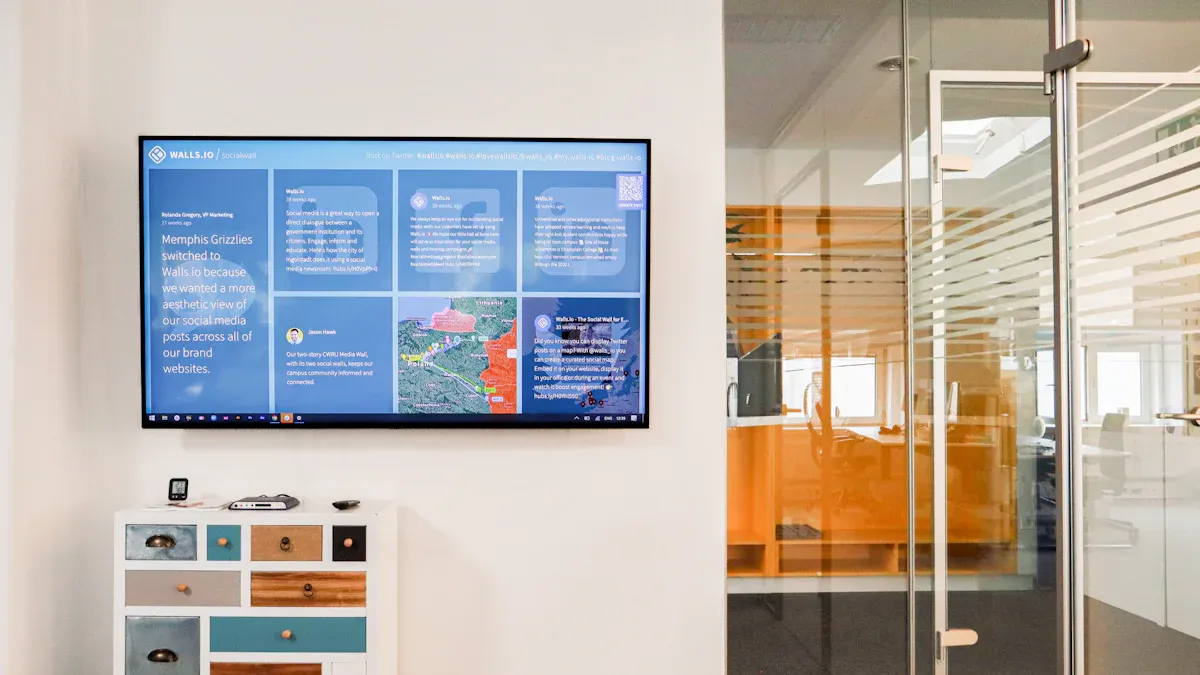For information about how Screenfluence can help your business with digital signage, please don’t hesitate to contact us by calling 1-844-772-7336 or emailing info@screenfluence.com.
Contact UsKey Trends Driving the Power of Digital Screens
AI-Driven Content for Smarter Engagement
AI is transforming how you interact with digital signage. It personalizes content based on data like age, gender, and even real-time behavior. Imagine walking past a screen that instantly tailors its message to match your preferences. This level of personalization boosts engagement and keeps your audience hooked. Businesses are also using AI to create adaptive displays that respond to their environment. For example, an interactive kiosk in a museum can guide visitors away from crowded areas, improving their experience. AI-driven content doesn’t just grab attention—it increases retention and can even enhance engagement rates by up to 40%. With AI, digital screens become smarter, more dynamic, and incredibly effective.
Blockchain Integration in Digital Signage
Blockchain is revolutionizing digital signage by adding layers of security and transparency. It ensures that every piece of content displayed is authentic and tamper-proof. For instance, each update is logged on a blockchain, preventing unauthorized changes. This technology also simplifies workflows by automating payments through smart contracts. Companies like MetaX have introduced platforms that allow advertisers to track ad performance without relying on third parties. Blockchain doesn’t just secure your signage—it makes it more efficient and trustworthy. You can now confirm ad delivery and audience engagement in real time, reducing fraud and boosting confidence in your campaigns.
The Rise of Interactive Displays
Interactive displays are changing how you engage with screens. These displays let you interact through touch or gestures, making them perfect for educational settings, business meetings, and even museums. Did you know that 60% of customers engage more with interactive displays? They’re also driving impulse purchases, with 62% of shoppers making unplanned buys after seeing an appealing display. Whether it’s a virtual reality meeting room or an augmented reality shopping experience, interactivity is redefining how you connect with your audience. It’s not just about showing content—it’s about creating an experience.
Hyper-Personalization in Digital Signage
Hyper-personalization takes digital signage to the next level. It goes beyond basic data like age or location, diving deep into personal preferences and behaviors. AI and live data work together to deliver content that feels tailor-made for each viewer. Campaigns like Deutsche Bahn’s “No Need to Fly” used hyper-personalization to target travel enthusiasts, achieving an 850% click-through rate. Netflix also uses this strategy by customizing thumbnails to match your viewing habits. This approach doesn’t just enhance engagement—it builds a connection with your audience, making them feel seen and valued.
Technologies Enhancing Digital Signage Impact

Advanced Display Technologies Revolutionizing Visuals
The world of digital signage is evolving fast, thanks to cutting-edge display technologies. From flexible displays that bend and fold to immersive screens that transport you into virtual worlds, the possibilities are endless. Here’s a quick look at some of the most impactful advancements:
| Technology | Key Features | Applications |
|---|---|---|
| Flexible Displays | Thin, lightweight, unique form factors; low-cost roll-to-roll manufacturing | Wearables, automotive HUDs, smartphones |
| Immersive Displays | Enhanced perception, panoramic virtual screens | VR environments, AR shopping |
| Micro LEDs | Self-illuminating pixels, modular design, longer lifespan | Large screens, custom displays |
| OLEDs | Flexible, efficient, improved image quality | TVs, smartphones, monitors |
These technologies don’t just improve visuals—they redefine how you experience content. Imagine walking into a store and seeing a vibrant, lifelike ad on a micro LED screen. It’s not just a display; it’s an experience that grabs your attention and keeps you engaged.
Real-Time Data Analytics for Targeted Campaigns
Real-time data analytics is a game-changer for digital signage. It helps you understand your target audience better by analyzing demographics like age, gender, and interests. With tools like face detection and foot traffic metrics, you can adapt content dynamically. For example:
- A/B test different messages to see what resonates most.
- Deliver personalized messages based on live data broadcast.
- Use predictive analytics to maintain operational efficiency.
This approach ensures your screens always show relevant content, creating a better experience for your audience. It’s not just about displaying ads; it’s about connecting with people in real time.
Cloud-Based Solutions for Seamless Content Management
Managing a digital signage network has never been easier, thanks to cloud-based solutions. These platforms let you control multiple screens from anywhere, making content updates a breeze. Here’s why they’re a must-have:
| Feature | Benefit |
|---|---|
| Remote Access | Control your screens from anywhere in the world, enhancing efficiency and flexibility. |
| Automatic Updates | Software upgrades and maintenance are handled by the provider, reducing IT workload. |
| Scalability | Easily expand your digital signage network as your business grows. |
With cloud-based tools, you can focus on creating impactful content while the platform handles the technical side. It’s a win-win for efficiency and creativity.
IoT-Enabled Interactive Digital Signage
IoT is taking interactive digital signage to the next level. Imagine a digital menu board that updates in real time when an item sells out, or a screen that shows ice cream ads when the temperature hits 80°F. IoT makes this possible by connecting screens to sensors and other smart devices. Key applications include:
- Touchless interactions through smartphones.
- Voice-activated displays for better accessibility.
- Real-time updates for public transit schedules or emergency alerts.
This technology doesn’t just make signage smarter—it makes it more responsive and engaging. You’re not just showing content; you’re creating a dynamic experience tailored to your audience.
Future Trends Shaping Digital Screens

Augmented Reality and Virtual Reality Integration
Augmented reality and virtual reality are reshaping how you interact with digital signage. AR lets you experience interactive content in real-world settings. For example, you can scan a QR code on a digital screen to try on clothes virtually or explore a product in 3D. This makes shopping more engaging and convenient. In healthcare, AR is even assisting in surgeries and diagnostics, proving its versatility.
VR, on the other hand, immerses you in entirely new environments. Imagine walking into a store and stepping into a virtual showroom through a VR-enabled screen. This creates memorable experiences that boost brand engagement. With innovations like spatial computing and gesture-based interactions, AR and VR are making digital signage campaigns more dynamic than ever.
Holographic Advertisements and 3D Displays
Holographic advertisements are no longer just sci-fi dreams. These displays grab your attention by presenting products in stunning 3D. They’re interactive, allowing you to engage with the content directly. Industries like retail and entertainment are adopting this technology to create unforgettable brand experiences.
Holographic displays also evoke strong emotional responses, helping brands connect with you on a deeper level. For example, a 3D hologram at an event can showcase a product in a way that feels almost tangible. With advancements in AI and AR integration, holographic signage is becoming more personalized and impactful.
Digital Screens in the Metaverse
Digital screens are the backbone of the metaverse. High-definition LED displays bring virtual worlds to life, offering realistic visuals and immersive experiences. Businesses are leveraging these screens to create unique virtual environments. For instance, Gucci’s virtual garden in Roblox lets you explore and purchase exclusive digital items.
These screens also support interactive features like motion sensors, enhancing your engagement. Their energy efficiency and long lifespan make them a sustainable choice for metaverse applications, reducing costs and environmental impact.
Sustainable and Energy-Efficient Digital Signage
Sustainability is a growing focus in digital signage trends. Modern LED technology consumes less power and lasts longer, reducing waste. Features like automated brightness adjustments and power-saving modes help conserve energy. For example, screens can dim automatically in low-light conditions or shut off during inactivity.
Eco-friendly materials and recyclable components are also making signage greener. Some companies are even adopting eInk displays, which use minimal power. By choosing sustainable signage solutions, businesses not only reduce their carbon footprint but also align with consumer demand for eco-friendly practices.
Strategies to Maximize the Impact of Digital Screens
Aligning Digital Signage with Business Objectives
To make the most of digital signage, you need to align it with your business goals. Start by understanding what you want to achieve. Are you looking to boost brand awareness, improve customer experience, or drive sales? Once you’ve defined your objectives, choose the right technology that supports them. For example, interactive kiosks can enhance customer engagement in retail spaces, while large LED screens work well for outdoor advertising.
Next, focus on your target audience. Conduct demographic research to tailor your content to their preferences. A well-planned content calendar can help you balance promotional and informational messages. Placement is equally important. Position your signage in high-traffic areas like store entrances or waiting zones to maximize visibility. Finally, integrate your signage with existing business systems for real-time updates and use analytics tools to measure performance.
Pro Tip: Regularly review your strategy to ensure your signage stays aligned with your evolving business goals.
Designing Engaging Interactive Displays
Interactive displays are a game-changer for digital signage. To design engaging screens, start with strategic placement. High-traffic areas like malls or retail stores are ideal. Ensure the height and angle of your screens are comfortable for all users, including children and those with disabilities. Lighting also plays a crucial role. Avoid glare by considering ambient lighting and using anti-glare coatings.
Interactive features like touchscreens or motion sensors can make your signage more engaging. For instance, kiosks in retail stores can allow customers to browse products or check inventory. These features not only attract attention but also create memorable experiences that keep customers coming back.
Measuring and Optimizing Digital Screen Performance
Tracking the performance of your digital signage is essential for success. Use key performance indicators (KPIs) to measure effectiveness. Here’s a quick guide:
| KPI | Description |
|---|---|
| ROI | Measures the return on investment for digital signage. |
| Screen Traffic | Tracks the number of viewers interacting with the screen. |
| Impressions / Engagement | Evaluates how many times content is viewed and engaged with. |
| Average Dwell Time | Measures the average time viewers spend looking at the content. |
| Conversion Rate | Tracks the percentage of viewers taking a desired action. |
By analyzing these metrics, you can identify what’s working and what needs improvement. For example, if dwell time is low, consider updating your content to make it more engaging.
Staying Ahead with Emerging Trends in Digital Signage
The digital signage industry evolves rapidly, so staying ahead of trends is crucial. Keep an eye on new technologies like augmented reality or AI-driven content. Before adopting them, assess whether they align with your business goals and budget. Partner with reliable vendors to ensure smooth integration and conduct small-scale tests before full rollouts.
Continuous improvement is key. Collect data and feedback to refine your signage strategy. By staying proactive, you can leverage the latest innovations to maintain a competitive edge.
Digital signage has revolutionized how you communicate and connect with your audience. From retail to healthcare, it’s reshaping industries by delivering dynamic, real-time content. To stay competitive, you need to embrace innovative technologies like IoT and AI. Start small—evaluate your goals, choose the right tools, and track performance. Outdoor digital signage, for instance, can amplify your brand’s visibility while enhancing communication with your customers. By leveraging digital media effectively, you’ll unlock new opportunities for growth and engagement.
Tip: Regularly update your strategy to keep pace with evolving trends and audience expectations.



